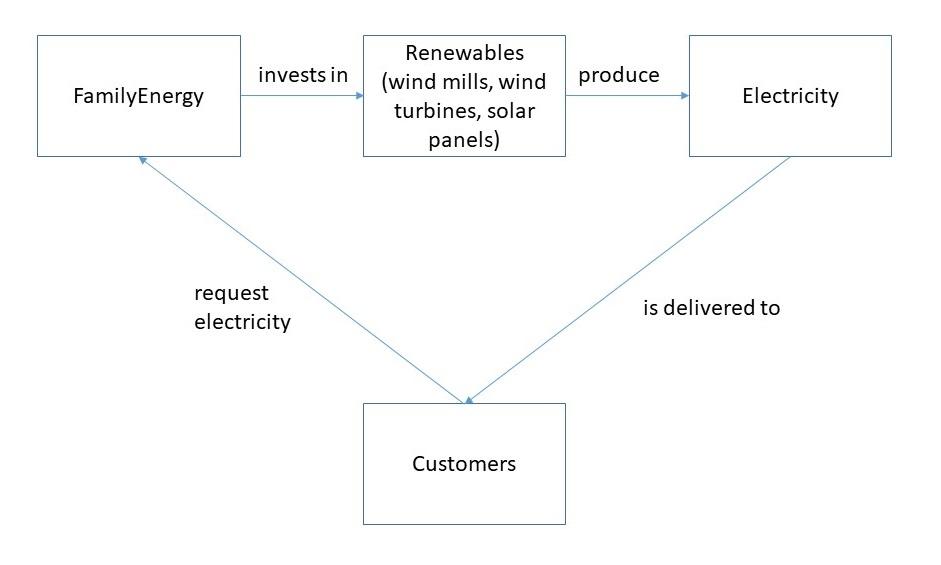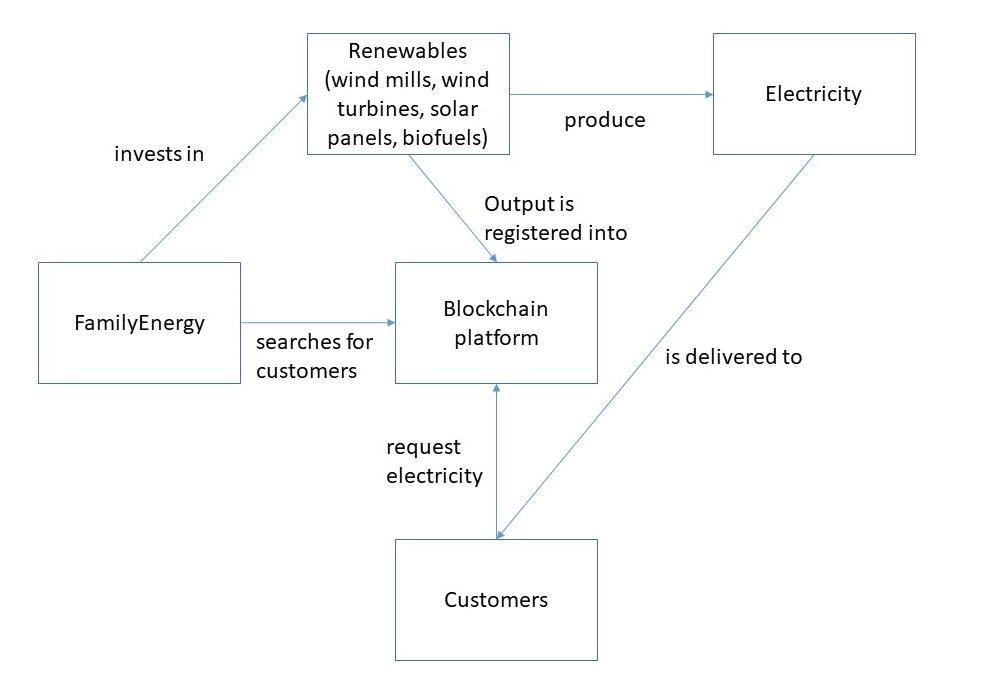Operations Identification & Assessment
FamilyEnergy is a Western-European company specializing in renewable energy. The main activity of the company is producing and selling electricity. This means that the first current operation is investments in windmills, wind turbines, and solar panels. The second operation is the installation of equipment necessary to harvest natural energy. The company contacts customers and commissions the construction of devices, which comprise the renewable energy infrastructure. The third operation is the production of electricity, which will be distributed to customers. It entails the generation of electrons from wind or sunlight within the respective devices. The fourth operation is distribution, which incorporates the maintenance of wires that convey electricity to customers. However, at this moment, Romande Énergie is the only customer business. The current high-level process map is depicted in Image 1.

Top Opportunities to Improve Operations
FamilyEnergy’s operations have several weak areas, which should be improved. First, the company is too dependent on its only customer. Romande Énergie allows the company to work with large infrastructure projects, which enable the installation of renewable sources of energy. However, the current market conditions render wind and sunlight insufficient for maintaining the revenue volumes. Therefore, FamilyEnergy ought to expand its customer base by including customers of Romande Énergie and other clients who want to receive electricity without any contractors. Looking for more customers is the first opportunity, which is also a new operation for a company because it is no longer expected to work with the same partners.
One of the reasons why FamilyEnergy has found itself in crisis lies in the lack of diversity in its selling units. Global warming has rendered the seasonability of wind and solar energy unpredictable. The second opportunity is the diversification of renewable sources that FamilyEnergy can use to produce electricity. Specifically, the company can invest in biofuels, which constitute the use of biomass to generate energy. It is a more flexible asset than wind and sunlight. Producing biofuels also requires special equipment, which has to be installed. The subsequent implication is that the business operation regarding the construction of infrastructure should be enhanced to include biofuels.
The third opportunity is the digitization of all corporate operations by using blockchain. It is a modern database, which stores all key business data. Blockchain is a safe and mobile solution to communications among the company’s employees and with customers. Not only will the information about customers reside in the database, but it will also include renewables’ output and corresponding market data. The third operation is uploading all key data into a blockchain platform, which will enable management to oversee all operations so that no business imitative can lose momentum. This process map change is the most important and requires step-by-step implementation. The gradual introduction will allow employees to familiarize themselves with the new system and expand as the need arises, thus making this innovation sustainable. The new high-level to-be process map is depicted in Image 2.

Implementation Plan
There are three steps in implementing changes to FamilyEnergy’s operations. The first is the digitization of processes via a blockchain platform. In order to accomplish this, the company should contact IBM, which helps its partners institute this technology. As soon as the database becomes operational, all information about customers and installations that produce wind and solar energy should be uploaded into it. Finally, businesses that require FamilyEnergy’s services should have access to the platform to enable quick transactions.
The second step is the search for customers beyond the contractors. Green Deal for Europe is an EU program aimed at developing a green economy with the use of renewable sources of energy. FamilyEnergy can use the support from the authorities to help find customers as part of a larger European initiative. Another option is to analyze how contractor companies such as Romande Énergie approached clients and offer more favorable conditions in comparison. Once the popularity of the company rises, customer influx will increase and all communications will be registered on the blockchain platform.
The third step is the enhancement of tools for producing electricity. The company should start investing in the generation of biofuels. By burning biomass, FamilyEnergy will be able to produce electricity, thus diversifying its income. Accomplishing it requires the installation of facilities where bioenergy can be generated. The company should follow the same procedure it used with solar and wind power – by implementing financial incentives with a similar expiration date. Combined with the support from the Green Deal for Europe, the return of investments will allow FamilyEnergy to sell electricity at a suitable price. Overall, biofuels constitute the final step in the implementation plan.
Appendix A
Interview Transcript 1
How do you see operations in your organization?
My company is a contractor for businesses which produce energy. As it does not generate the power itself, there are two operations – communication with suppliers and distribution to customers.
What do you think is the biggest pain point in operations for your organization?
I think that weather fluctuations caused by global warming are a major obstacle to the company’s distribution schedule. As forecasts become less accurate, the organization becomes less able to assure customers and investors of sufficient production volumes.
Do you observe continuous improvement in your organization’s operations, do you have any examples?
The company was forced to lower the price of its services but managed to maintain the client base. As more customers started using the company as an electricity distributor, the operations became broader in scope and thus improved.
From your perspective, are operational changes difficult to implement in your organization?
In my opinion, the organization has certain difficulties with new operational solutions since there is not much flexibility available to distributors of energy.
Does your company have a digital strategy? Is it aligned with the overall operational strategy of the organization?
Yes, management wants to implement digital dashboards to have a better understanding of the company’s performance. Doing so is in line with the strategy organization, which prioritizes qualitative customer service.
Appendix B
Interview Transcript 2
How do you see operations in your organization?
The company generates hydroelectricity, so the operations are the operation of water turbines and distribution to customers.
What do you think is the biggest pain point in operations for your organization?
Operation of dams pollutes the environment, thus defeating the entire purpose of a renewable source of energy.
Do you observe continuous improvement in your organization’s operations, do you have any examples?
No, the power plant continues to spoil the quality of water, which sometimes affects the production of electricity. This issue remains unresolved.
From your perspective, are operational changes difficult to implement in your organization?
As long as operational changes are within the organization, they are possible. When they concern water, changes are difficult because the technology is not advanced enough.
Does your company have a digital strategy? Is it aligned with the overall operational strategy of the organization?
The company actively pursues minimization of human input, substituting people with AI. As the company’s strategy is finding the most effective way of deriving electricity from water, it corresponds with the digital strategy.
